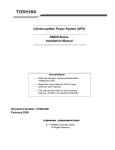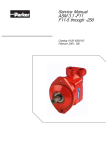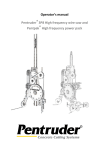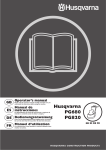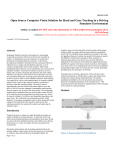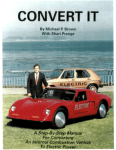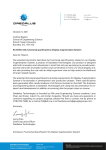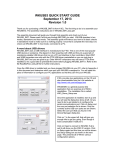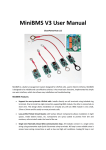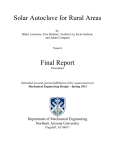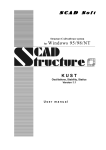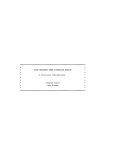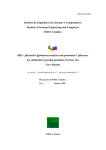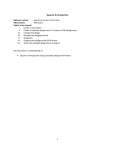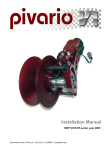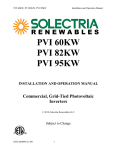Download Zero Emission Design Paper
Transcript
E62 The Best Electric Snowmobile Ever!! Author, co-author (Do NOT enter this information. It will be pulled from participant tab in MyTechZone) Affiliation (Do NOT enter this information. It will be pulled from participant tab in MyTechZone) Copyright © 2012 SAE International ABSTRACT The Clarkson University Electric Knights (CUEK) has developed a lightweight snowmobile based on the Ski Doo REV XP platform. The new snowmobile has a [50km (30 mi)] range under optimal conditions; leading to an [18] mile improvement. CUEK have been building electric snowmobiles for participation in the SAE Zero Emissions Snowmobile Competition since 2007. These six years of experience led to better deign decisions and therefore, a better snowmobile. The new snowmobile has greatly improved handling, range, acceleration, aesthetics, and [electrical designs]. To do this, the team utilized its knowledge to balance the weight throughout the snowmobile, minimize weight while retaining strength and structure in the motor mount design, optimizing gear sizes, and [using a more efficient battery layout and wiring]. The battery system consists of 900 LiFePo4 individual cells that each provides 8.3 Wh of energy and up to 40 kW of power. These batteries have superior thermal capabilities and chemical stability. The use of MiniBMS by Clean Power Auto as our Battery Management System (BMS) monitors the cells and equalizes the batteries for safety and performance. The use of an Azure Dynamics motor controller to manage a highly efficient Azure Dynamics AC24 Motor that has a continuous torque of 31 Nm at 4000 RPM helps to improve our range. chemicals in the atmosphere like a sponge. National Science and Forestry’s Summit Station is performing research on such chemicals that may be measured in only parts per billion. Thus, a mode of transport that has zero emissions has been sought after for many years. With the recent advancements in battery and motor technology, it is now possible to fill this need. DESIGN STRATEGY The 2011 snowmobile proved to be a great design. To build upon the successes of the 2011 snowmobile design, Clarkson Electric Knights decided to go with the REV XP snowmobile chassis from a 2012 Ski Doo MX Z Sport 600 ACE. This chassis is in the Ski Doo MX Z Sport with the Rotax 600 Carb engine has a dry weight of 190.5 kg (420 lbs). A weight of which is a 24.9 kg (55 lbs) drop in weight (previous sled’s dry weight was 215.7 kg (475 lbs). The Rotax 600 Carb engine is similar to the engine in the stock Polaris, so comparing the weight of the two sleds this way better shows the difference is the frame weights. On the mechanical side of things, a two stage gear reduction leads to an overall gear ratio of 3.2:1 with minimal lost in efficiency through the use of custom tensioning, gears, and two Gates Carbon Polychain Belts. INTRODUCTION National parks and other pristine areas that are environmentally sensitive are in need of a mode of transport that is quite, has zero impact on the environment, and can travel long ranges on a single charge while also towing equipment. The Greenland Ice Cap is such an area; absorbing Page 1 of 12 Figure 1. Stock Ski-doo MXZ Sport 600 ACE. In addition to a change in chassis, the 2013 Zero Emission (ZE) snowmobile design strategy included dropping weight where it was safe to do so. This is because a drop in weight means the motor will not have to pull with as much torque in order to accelerate the sled. Then the motor would require less energy from the batteries, and thus the batteries will have a longer life before they become to low to drive the sled. Therefore, lighter weight directly leads to a greater range with the same battery pack. A greater range was another design goal. Concurrent with dropping weight, the 2013 ZE Snowmobile has 84 more individual LiFePo4 cells leading to a total count of 900 individual cells. To avoid complications with the electric system, increase safety, prevent the need for repairs, and to lower the 2013 ZE snowmobile’s MSRP, the use of more simplified circuits and analog only BMS boards was incorporated in the 2013 design. The basic design strategy was to ‘keep everything simple” for safety and reliability. Goals The goal of the competition in Michigan is to determine whether an electric snowmobile can be adequately used in Greenland’s Summit Station by the NSF. Every event in the completion is important, but from the experience of the CUEK visiting Greenland, certain events stand out as more important. These events are the range event, the draw bar bull, acceleration plus load event, subjective handling, and cold start events. By performing well at these events, it leads to a snowmobile that can be very realistically used at Summit Station in Greenland and effectively aid in the research being performed there. Table 1. The possible points that may be obtained for each event. [7] Zero Emissions Class Events Minimum points for minimum performance Maximum Additional Points Manufacturer’s Suggested Retail Price (MSRP) 2.5 50 Oral Presentation 5 100 Weight 0 100 Range 5 100 Draw Bar Pull 5 100 2.5 50 2.5 50 Acceleration + Load Event Objective Handling and Drivability Page 2 of 12 Table 1. Continued. The possible points that may be obtained for each event. [1] Zero Emissions Class Events Minimum points for minimum performance Maximum Additional Points Subjective Handling 2.5 50 Cold Start 2.5 50 Objective Noise 3.75 75 Subjective Noise No-Maintenance Bonus Engineering Design Paper 75 100 5 100 Static Display 0 50 Total 36.25 1050 When CUEK took the point weighting for the Clean Snowmobile Challenge events into consideration, it was decided that a focus of reliability, the range event and weight, design of the snowmobile, and the draw bar pull event. The draw bar pull event is the event where a snowmobile must pull a progressive resistance in weight at four miles per hour until it can no longer proceed due to a lack of traction and/or power. During the event, the driver of the snowmobile is not permitted to bounce the snowmobile so as to gain traction for the sled. The maximum draw bar pull load is then measured and recorded. Points are determined by awarding the winner 100 points and then using a linear scale to determine the amount of points for each successive place. For the range event, the judges set a speed limit of 20 mph that the snowmobile must travel on a closed test course at until it cannot move any farther. The team that travels the furthest receives 100 points. Based on a linear scale, teams who compete in the event will receive an appropriate score where the team that achieves the least amount of miles in range will be given a score of 5 points. 5 points will be given to team that achieves the minimum requirement of 500 feet. As for the weight event, each team’s snowmobile will be set on scales during inspection to determine each sled’s weight. The team with the lowest weight receives 100 points. Once again a linear scale will be employed. Reliability was most important to CUEK this year. This is not only because reliability will aid in avoiding complications that have arisen in past years and that have then impeded on past performances. The other reason for reliability being a top goal is because there is a one hundred (100) point no-maintenance bonus. Any team that does not need to repair or service their sled during the completion will receive 100 points. Reliability in CUEK’s design goals is important in considering the use of the Zero Emissions snowmobile. The snowmobile is meant to be used by researchers in remote areas where maintenance and repair will be scarce. Good design is incredibly important in engineering. By considering the life cycle of the snowmobile in one’s design, one not only develops a better snowmobile, but reduces costs in manufacturing. Thus, it leads to a lower MSRP. An excellent design also leads to less need in maintenance over the life of the produces and a greater level of reliability in the product. Good design is rewarded in the SAE clean snowmobile challenge in no only the events such as the range event and the draw bar pull event, but in the Design Paper and the Oral Presentation. In these events, a team can explain their thought process behind their product. These two events total 200 points, which should encourage teams to put time and effort in their design. CUEK noticed this and plan their work so that CUEK develops good designs. [8] INNOVATION AND PAST WORK A key point in the design this year was incorporating new ideas, change established norms, and introduce a new electric snowmobile that is not only functional, but ascetically appears close to stock. Everything was kept simple. The design of the motor mount, the gearing, and the battery box can all be sold as simple conversion kits that anyone could use to convert their Ski doo REV XP to an electric snowmobile in a weekend. In the drive to drop weight, a motor mount was designed that does not even weigh in about 15 lbs. Where it was safe and convenient, aluminum gears were utilized in place of stock iron or steel. The only material added to the sled was material deemed necessary for rigidity and safety under the worst conditions. Though the University of Alaska at Fairbanks has used the Rev XP chassis before for conversion to a ZE Snowmobile, The Clarkson ZE snowmobile has a more even weight distribution and differs in almost every other aspect. The use of two stage gear reduction that was optimized with consideration of space restrictions greatly increases our efficiency and is new to this chassis. Another goal with gearing was to design the gears so that transmission of energy through the drive train would be efficient and lead to a higher acceleration. A larger torque at the gear connected to the track is desired so that improved performance can be seen in the draw bar pull. The 2013 snowmobile by CUEK is innovation in its simplicity with reliability at the top. Previous Work Over the last six years, the Electric Knights have worked to convert an internal combustion (IC) snowmobile to a fully electric utility snowmobile. This past year, safer, more Page 3 of 12 reliable batteries were chosen to power the snowmobile; an improvement over the lithium polymer cells used in previous versions of the snowmobile. These batteries needed to meet specifications for output current, voltage, and operate in conditions required by competition and the NSF. An energy density that is as high as possible is desirable so that the cells supply as much energy as possible at a lower cell weight. A high power density or volume power density is also desirable. This is because if each cell has a higher power density, less space will be taken up by each cell, and thus when constrained in a specific space, there will be more energy in the constrained space. With a high energy density and high power density, it is possible to get the power needed to complete the events that require the snowmobile to run under a load. With more power the events such as the Draw Bar Pull as well as the Range event are accomplished more easily. As the main power system involves a large quantity of cells, it is essential to use a Battery Management System to normalize the system. This BMS equalizes each individual pack as well as preventing any pack from sinking below the minimum operating voltage. By protecting the batteries from falling lower than its minimum voltage, no one battery will cause the entire battery system to perform inadequately or fail. Included within the BMS is the capability to sense variables of each battery pack to allow the user to monitor the system. A close watch of the temperature, voltage and current output of the batteries can be used to keep the snowmobile operating safely. For example high temperatures, currents or drops in voltage are all indications that the snowmobile needs to be serviced. Balancing the speed and torque applied to the track is also necessary to increase the snowmobile’s performance when towing a load. The use of a more efficient motor controller allows more power to pass from the main battery system to the motor increasing both speed and torque and the range of the snowmobile. Secondly, the gear ratio can be adjusted. Speed and torque are inversely related with this adjustment; in other words an increase in speed leads to a reduction in torque and vice versa. With somewhat less emphasis on acceleration and the event requiring the snowmobile to tow 500 pounds for 500 feet, more torque is needed. While taking into account that the events are still time based, ratios for gears still need to be able to provide the torque needed, at the same time moving at a utilitarian speed. Another improvement made to the conversion was the elimination of the oil-filled chain drive system that is found stock on the IC Snowmobile. Instead a belt driven drive system was implemented. Use of a belt driven system, instead of the chain drive makes the snowmobile substantially quieter. Not only does switching to this system help with the noise event, but in fact it played an important part in helping with the handling of the snowmobile. In the process of switching to a belt driven system, the placement of the motor was altered. The motor was moved to a position lower than it was in previous years allowing a more desirable center of gravity for the snowmobile, improving handling. Through past years at the Clean Snowmobile Challenge the weight of the snowmobile has varied due to changes in the design. To help improve performance, the team sought to reduce weight where possible on new and existing components on the snowmobile. With a lower weight, less energy will be needed in the snowmobile, thus giving it a larger range. Finally, a reasonable cost is preferable, and since cost is one of the main goals, there was a very large portion of time spent researching the least expensive parts that would not sacrifice the safety or overall performance of the snowmobile. Reliability is also very important to CUEK, so careful planning and design when into BMS choices, battery cell choices, and mechanical designs. BATTERY MANAGEMENT SYSTEM CUEK spent time looking at different BMS systems to regulate the battery pack. In the past CUEK has had mixed reactions with BMS systems. Some were custom built while others were purchased systems. In 2013, CUEK chose the miniBMS for simplicity reasons; it’s a hands off system as far as user preferences and interface goes. You can view the important information about your pack and not much more. In the past experiences there have been issues with more complicated and in depth systems which will give the user more information on the pack. These systems frequently had issues with reliability and seemed to ‘fault’ for no apparent reason. The miniBMS is also more powerful than previous systems. It can discharge 750mA [1] from each individual cell versus a previous 250mA. This was an important factor to consider when choosing a BMS since the balancing Lithium cells is very important for pack health and safety and life. Figure 3. Wiring Diagram for the MiniBMS [1] MOTOR CONTROLLER CUEK chose the Azure Dynamics DMOC445 motor controller to regulate an AC24 motor. It is marketed as rugged and waterproof. It has an inverter for controlling 3-phase AC motors and generators. This motor controller was chosen based upon its past successes in our previous work. It is very configurable by the user to optimize individual settings and requirements. This model also boasts gold Irradiated per MILC_5541-E-Class 1a as a component cover for corrosion protection. The base of the heat sink is also comprised of this material. Figure 4: DMOC 445 Motor Controller Figure 2: MiniBMS The BMS boards should be installed with the ring terminal attached to the negative side of the battery terminal. The red lead wire will then be attached to the positive terminal of the battery. In accordance with the user guidelines for this particular BMS board we attached the BMS terminals on top of copper links. Page 4 of 12 The maximum and minimum cooling pressure for the motor control on the inlet side is 12-10 psig, while the maximum and minimum cooling temperature at the inlet is +55C and +40C. The cooling flow rate is 7.5 to 10 LPM at 1.4 and 2.5 psi, respectively. [3] Table 2. Specifications on Motor Control [3] BATTERIES OVERVIEW For this build CUEK considered several battery options to assemble the battery pack. One goal was for the batteries to output more power while staying within the optimal voltage for the motor controller. CUEK needed a battery that could output a lot of power, be resilient to the effects of cold, have a high energy density and most importantly, be safe. Immediately, CUEK considered a few different lithium iron phosphate cells (LiFePO4). This chemistry has worked incredibly well for CUEK in the past and is much safer than a lithium polymer cell. In design you need to consider the entire life of the product. In this case, one must consider how the batteries will be recycled or reused at the end of the snowmobiles life. When compared to other batteries, LiFePO4 have the best balance of safety, cost, and end of life environmental impact. FUSING The importance of fusing a battery pack in an electric vehicle is very important. In the event of failure fuses will protect the pack from and the user from damage. Since our pack was built from many smaller cells assembled in parallel and series we needed to protect the parallel connections should a cell short out or a short occur within the pack. To do this we used fuses with axial terminals, we mounted these to tabs spot welded onto the cells, and this prevented any damage to the cells from soldering. Using direct mounted rated fuses we bypassed any need for complex monitoring systems of the fuses. This would’ve been very difficult since we have so many parallel connections. Our pack is also fused by a full power rated fuse as another method of protection. In the past, CUEK has used K2 Energy 26650P cells, which are a high output LiFePO4 cell in a small cylindrical case. CUEK have been very happy with these cells in the past but wanted to consider other types of cells. After much research and then comparison of data sheets and discharge curves, the same K2 cells were decided to be used once again. These cells are arranged into fifty packs in series. Each pack is comprised of eighteen cells in parallel. Battery Container and Design Fitting all 900 cells was going to be a challenge it works out to be a big heavy pack no matter what. There is one large battery box that contains the battery cells and the BMS boards. It is placed under the driver. A large amount of design went into the battery box. This location is the same location as the original fuel tank. To contain all the batteries in one box helps to simplify the design and makes maintenance easier. Figure 5. 16 amp fuses with 250 volt rating. [] The fuses are rated for 16 amps and 250 volts. The fuses have an interrupting rating of 500 A. Nominal cold resistance is 0.0031 ohms. The nominal melting is 1408.0 A2 sec. The addition of these fuses between each battery cell greatly increases the safety of our battery back since they work as a first response. There are fuses in between each pack of cells. Page 5 of 12 Figure 6. Mock-up of battery box in SolidWorks Aesthetically, the sled does not look exactly like stock since the battery box extends behind the seat. The battery box not only protects the batteries from the snow and the environment but it also protects the rider from the batteries in that rare case of failure. The battery box is structurally sound and strong through the use of an aluminum frame and polycarbonate siding. The polycarbonate also works as an electrical insulator. Aluminum of 1/16” thickness was used to fireproof the battery box in compliance with the 2013 ZE Rules. Comparing the discharge curves below the K2 energy cells appear to output less power at the same current rating. Since the K2 cells are only 2.6Ah, vs the 12Ah of the headway cells looking at the 5amp load for the K2 cells gives a much better picture of how the cells would perform if a ~12Ah pack made from K2 cells would be tested. Another reason for mounting the pack under the driver is to give the sled a more centralized weight distribution. In the past the sled has had a somewhat front heavy snowmobile. With most of the weight on the front skis, turning the sled could become difficult. This made it hard for some people to handle the sled. The new sled does not have this issue and handling is much improved. The battery box must contain 900 batteries safely. These 900 batteries are 160.7 lbs (72.9 kg) alone. A typical tank for an IC snowmobile holds around 42 lbs of gasoline. The BMS boards and the aluminum frame also add some further weight. Another deciding factor for using the K2 cells was the size factor, the smaller diameter cut down on the amount of lost airspace between the cells. Also the larger size of the cell restricted how the pack can be laid out. Considering the goal of keeping the pack hidden and the seat at near to stock height, the headway cells clearly had a disadvantage. The construction of the pack is complicated due to the need for strength and safety. CUEK chose to do a polycarbonate box braced with angle aluminum for rigidity. To hold the pack down and keep the lid on, CUEK designed ‘straps’ made out of square aluminum tubing, these bolt to the chassis and form a cage around the pack. This cage gives the sled a simple way to hold the lid on, keep the pack firmly mounted in place and creates a location for the seat to be mounted on. Battery Selection Figure 8. K2 Energy cells’ discharge rates for different currents. [5] After much research, comparison of data sheets and discharge curves we settled on the same K2 cells, as tried and true performers and 12Ah cells made by Headway Headquarters. The advantage to the headway cells would’ve been a fewer parallel connections between the cells only 4 versus 18. They also featured bolted ends. We purchased several test cells and discharged them several times under various loads to observe temperature rise and voltage drop. Despite the simplified electrical systems that the Headway cells could provide, they had one more downfall that CUEK didn’t initially expect. The bolted connections seemed better on paper than in reality. While they were easy to put together and take apart, they were somewhat limiting on pack configuration since one would have to use a special tool to access to the terminals and the extra space would be taken up by the terminals and bolts. Voltage under 32 Amp Load 4 3 Voltage under 32 Amp Load 2 1 19 15 11 7 3 Time 0 Figure 7. Head way cells’ voltage discharged under 32 amps. Page 6 of 12 DRIVE TRAIN CUEK’s 2013 Snowmobile is zero emissions by its ability to run on only LiFePO4 batteries. This makes the gasoline engine superfluous and so it is removed. Removed along with the engine are the continuously variable transmission (CVT), fuel tank, muffler, and other associated parts. In place of these parts, an Azure Dynamics AC24 Motor and DMOC445 Motor controller were added. Though a CVT is very efficient by automatically adjusting to the necessary gear ratio, the CVT becomes unnecessary when using an electric motor. Gearing however, is still an essential part of the design. This is because the power from the motor can be transmitted efficiently and in the desired manner. A light weight and efficient way of transmitting power is through the use of a belt. Belts are lightweight and usually have a high efficiency value. After doing research on what is available, CUEK decided the best choice for the drive train was to use a Gates Poly Chain GT Carbon belt. In choosing what belt would be best for CUEK’s snowmobile, consideration was made towards efficiency, loudness of the belt while in use, cost, and ease of use. Timing belts or synchronous belts are a positive transfer belt that has teeth that fit into sprockets of matching tooth pitch. They require little tensioning and typically replace chains in designs. Timing belts also have no need for an oil bath unlike chains. Table 3. Comparison of Belt. [2] Belt Efficiency [%] Loudness [dB] Cost Ease of Use V-belt 90-95 <60 dB low simple Timing 98 73 dB moderate simple Timing belts are also very efficient in transfer of motion as they have no slippage when under correct tensioning. Disadvantages in using a timing belt are inability to use a clutch and cost. When using a timing belt, special sprockets must be used and the belts themselves are usually more expensive. In designing a zero emissions snowmobile, a clutch is not needed as the motor controller can modify the RPM. Vee belts (also known as V-belt) is the basic belt in power transmission. They have little to no slippage or misalignment. They typically have long life spans though they can lose up to 5% efficiency over a belts life [2]. V-Belts can withstand high speeds and large loads. They typically require larger pulleys since they have a large thickness. A wider width would not fit in the area constraints of the Rev XP chassis, so a timing belt would not work in this application. As can be seen in Table 2, Timing belts have a greater efficiency.[2] For this reason and for the other benefits of choosing timing belts, such as its long life and reliability (no slippage even over time), a timing belt was chosen over the V-Belt. Gear choice is very important in designing the drive train. Different gears can withstand different rotations per minute (RPM), have different weights; have a direct effect on power transfer and torque. Maximum speed and acceleration are determined by the gearing. As for gears, CUEK chose to use C3 Powersports 63-tooth sprocket gear in the bottom of the chain case and their 30 tooth sprocket at the top of the chain case. On the top of the motor side (on the jack shaft) is a 45 tooth gear from Gates. On the motor’s shaft of the same side is a 30 tooth gear was custom made motion systems. All the gears have a 8mm pitch. Both belts connecting the gears are Gates Poly Chain GT Carbon synchronous belts in the two stage gear reduction. Page 7 of 12 The 2013 snowmobile has an overall gear ratio of 3.15:1. This was found through the following equation: In CUEK’s history, gear ratio has not been constant. In 2008 a gear ratio of 5:1 where 80 Nm of torque at 4000 RPM was outputted. During the draw bar pull, the sled lost traction due to too much instant torque. In 2009, the gear ratio for the drive train was 2.5:1. This led to a 5kg loss in weight and the ability to perform well in the draw bar pull event. Greater torque was desired in the 2010 build so the gear ratio was then increased to 4:1 leading to a total torque of 360 Nm. The ratio of 4:1 permitted the snowmobile to pull 737lbs before losing traction. The 2013 snowmobile now has a motor that can output higher torques (peak torque of 75 Nm). CUEK calculated through the gearing and was able to determine the RPM of each gear and the tensioning pulley. At peak torque running with an efficiency of 95%, the torque out to the track is 224.7375 Nm. The power out with the same efficiency is 28.353 Kw at peak torque. This means the force out to spin the track is about 2244 N. Theoretically, when the sled moves at 3.5 m/s2 with an extra load of 500 pounds, the force needed to move the track is equal to 2067 N. The sled will be able to overcome static friction and pull 500 pounds as will be necessary in the acceleration plus load event and the draw bar pull. If the sled is moving at 1 m/s, this means that in 5 seconds, the sled with reach 5 m/s and in 10 seconds, the sled would reach 10 m/s. The speed of m/s is about 11.18 mph and 10 m/s is about 22.36 mph. At this acceleration, the sled can easily tow over our previous best of 737 lbs. The throttle on the snowmobile is very sensitive so the torque is slowly increased with the motor controller. This will improve the subjective handling. MOTOR The motor in the 2013 snowmobile is an Azure Dynamics AC24 induction motor. The motor has a high efficiency that peaks at 89% when running at 156 VC and 91% at 336 VDC. The motor weighs 38 Kg (83.8 lbs) and has minimum/maximum operating temperatures of -40°C to 55°C. [4] The ability of the motor to run at such low temperatures is imperative of any motor used in such applications as at the Summit Station in Greenland. Figure 9. Picture of the Azure Dynamics AC24 Motor. [4] The motor has two recommended optimal voltage it should run at, 156 VDC and 336 VDC. CUEK planned in 2012 to use this motor at 336VDC until the new rules for 2013 were released. The new rules state we must not run above 300 V so the lower optimal voltage had to be chosen. At 156 VDC, the motor outputs 75 Nm at peak torque. The continuous torque at this voltage is 31 Nm at 4000 RPM. 4000 RPM is also the nominal speed. [4] The efficiency of this new motor is consistently higher for all torques. The efficiency versus torque for CUEK’s old Solectria AC21 curve is not as flat as the presently used AC24. Figure 11. Efficiency versus torque for the AC24 motor at 336V. [3] When comparing figure 4 and figure 5, the peak percent efficiency is higher for the AC21. The AC24 motor however, maintains efficiency between 75-85% for the entire range of torques. As for the torque-speed envelop, the AC21 motor curve can be seen in figure 9 and AC24 curves can be seen in figures 10 and 11. Figure 11. Efficiency versus torque at 156 V. [3] When choosing a motor, it is very important to look at the torque curve and consider how the motor will work with the gearing in the vehicle. Below in figures 12-14, one can see the torque versus speed curves for the old AC21 and current AC24 motors. Speed is measure in RPM and torque is measured in Nm. The two plots for the AC24 motor also show the curve of peak output power versus speed. The units on power are kW. You should note the speed at which there is peak output power is the same speed at which there is peak torque. Figure 10. AC21 Motor Efficiency versus Torque curves. Page 8 of 12 longer range of speeds. The peak power is about 10 kW greater when running 336 V. Motor Mount The motor mount design is based closely on the 2011 snowmobile motor mount. The area in which the mount is placed is smaller with ununiformed angles, making the design of the motor mount more challenging. The most obvious place to put the motor is in the area that the IC motor was. In this position, the weight of the motor is very low. With it in this position, the handling will be improved from previous years. Figure 12. Torque-Speed envelop for the old AC21 Motor Figure 13. Torque-Speed envelop for theAC24 running at 156 VDC with a peak power curve versus speed in RPM. [3] The Torque-speed envelope Figure 14. Torque-Speed envelop for theAC24 running at 336 VDC with a peak power curve versus speed in RPM. [3] The original strategy of CUEK was to run the motor at 336 V. If the sled is run at this voltage, the peak torque is higher for a Page 9 of 12 Because of the confined space, the motor mount had to be carefully designed. To increase the structure of the lower motor mounting arms, the lower mount arms were designed to fit the pan perfectly. Figure 15. Stress on face plate connected to the motor. A finite element analysis on the entire mount was done along with a simple static and strength of materials analysis to check the safety of the design. The main face plate that bolts onto existing mounting holes of the AC24 motor was machined pout of 6061-T6 Aluminum. The maximum stress at the maximum torque the motor can produce is 1000 psi. In figure 15, one can see the stress study performed on the face plate. Figure 18.The stresses on one of the lower mount arms. Figure 16. Assembly of the motor mount with the motor in Solid Works The motor mount consists of two of these lower mount arms which follow the profile of the pan perfectly. The tight fit aids in the structure of the mounting. The blue color represents 2.6 psi, the green represents 507 psi, the orange is 843.4 psi, and the red represents 1000 psi. Below, in figure 17, one can see the displacements of points of the face plate due to maximum torque. Figure 19. Displacements on the lower mounting arm. The red color in figure 19 shows the greatest displacement the lower mounting arm might experience. This displacement is 3.3x10-5 inches. There is very little possible displacement and stress in the motor mount parts. These tiny displacements mean the motor mount will not vibrate much and therefore, will be very quiet. Figure 17. Displacements on face plate that attaches to the motor. Units are between 10-8 and 10-4inches. The red represents 1.6x10-4 in, orange is 1.34x10-4 in, the yellow is 1.2x10-4 in, the green is 8.0x10-5 in, and the blue represents 2.55x10-8 in. One of the unique things about this motor mount is it is very easy to install, light weight, and can be adjusted for a large range of belt sizes. Everything is still kept simple and easy to machine. The only parts of the motor mount that are harder to machine would be the lower mounting arms which had been machined through the use of a computer numeric control (CNC) in house. Below in figure 18 are the stresses on the lower mounting arms. Page 10 of 12 HANDLING One of the events at the Clean Snowmobile challenge is the subjective and objective handling event. Handling is clearly important since no matter how fast or efficient one’s sled might be, if it has bad handling, no one would purchase or use it. So good handing was one CUEK’s design goals. As discussed earlier, handing has never been the best on CUEK’s snowmobiles. This new build however, has taken a large majority of the weight that use to be in the front and distributed it under the seat. The weight was designed as low to the ground as possible to have a low center of gravity. A lower center of gravity greatly improves handling around turns. Because the batteries add significant weight, two new rear torsion springs two grades above stock were used in the rear suspension. This will allow riding of the snowmobile over large bumps like one would with the stock snowmobile. 9. Littlefuse. 215 series, 5 x 20 mm, Time-Lag Fuse. Littlefuse, 2012. Braking The breaks in the snowmobile were all kept stock. No modifications to the break were made. Plans have been made to incorporate regenerative breaking into the electric snowmobile. Unfortunately, this could not be utilized on the snowmobile this year. CONTACT INFORMATION SUMMARY/CONCLUSIONS The Clarkson University Electric Knights would like to gratefully acknowledge the support of Clarkson University SPEED Program, ECE and ME Department of Clarkson University and Clarkson University. The team would also like to thank its sponsors, C3 Performance, Gates Corporation, K2 Energy, and Ingles Performance. Without their support, this electric snowmobile would not have been possible. We would also like to thank Professor Morrison, Jonathon Young and the other employees in the CU Machine Shop. Based on the Ski doo REV XP platform, a zero emissions snowmobile was designed and built by Clarkson University Electric Knights. The new 2013 ZE snowmobile is theoretically capable of reaching speeds around 60 mph (96.5 kmh) in optimal conditions. The motor mount, the battery box, and the gearing can all be sold as conversion kits. The key word for the design this year was reliability. All analog BMS boards were used, and the circuitry was simplified. REFERENCES 1. Auto, Clean Power. MiniBMS User Manual. User Manual, Clean Power Suto, 2012. 2. "Belt (mechanical)." Wikipedia. n.d. http://en.wikipedia.org/wiki/Belt_%28mechanical%2 9 (accessed February 2, 2013). 3. Dynamics, Azure. DMOC445 and DMOC645 User Manual For Azure Dynamics DMOC Motor Controller. Azure Dynamics, 2010. 4. Dynamics, Azure. Force Drive Electric Drive Solutions. Azure Dynamics, 2010. 5. Energy, K2. "High Capacity LFP26650P Power Cell Data." 2010. 6. Energy, U.S. Department of Energy: Energy Eddicency and Renewable. energy.gov. n.d. http://www1.eere.energy.gov/manufacturing/tech_de ployment/pdfs/replace_vbelts_motor_systemts5.pdf. Feb. 2013 7. International, SAE. "2013 SAE Clean Snowmobile." 2013. 8. Keith Nisbett, Richard Budynas. Shigley's Mechanical Engineering Design. New York, NY: McGraw-Hill Companies, 2010. Page 11 of 12 Lindsay Borakove: [email protected] ACKNOWLEDGMENTS DEFINITIONS/ABBREVIATIONS BMS – Battery Management System IC – Internal combustion CUEK – Clarkson University Electric Knights RPM – Rotations per minute CNC – Computer Numeric Control CVT – Continuous Variable Transmission Page 12 of 12












